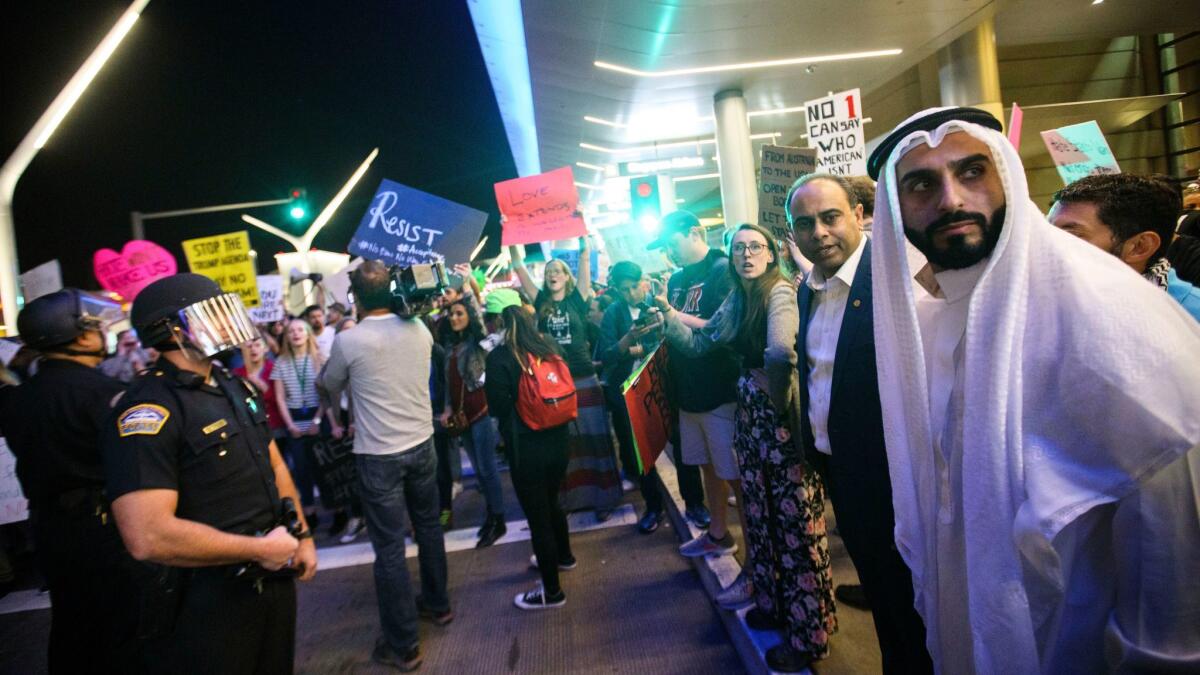Building Type: The airport as public square and protest central

- Share via
I’ve been writing about the relationship between political protest and the design of cities for more than 20 years, beginning with the senior thesis I produced as a terrifically naive undergraduate studying architectural history and political science in the early 1990s. But I can’t say I’ve ever covered a scene quite like the one that played out last weekend at LAX and other airports across the country.
In response to President Trump’s executive order to suspend the U.S. refugee program and temporarily prohibit entry to citizens of seven predominantly Muslim countries, protesters showed up at Birmingham-Shuttlesworth International Airport in Alabama and at Chicago’s O’Hare. They clogged parts of JFK and SFO as well as terminals in Dallas, Boston, Miami, Washington, D.C., Phoenix, Seattle, Albuquerque, Denver, Missoula, Mont., and Portland, Maine.
In terms of turnout — sheer numbers — the demonstrations were no match for the women’s march events held the day after Trump’s inauguration. In Los Angeles, the women’s march drew hundreds of thousands of people, the protests at LAX’s Tom Bradley International Terminal thousands or perhaps tens of thousands.
But the impact of the airport protests was in certain ways greater, or at least easier to measure. And more focused, since so many migrants travel by air; an immigrant here illegally is nearly as likely to be somebody who bought a plane ticket and overstayed his visa as somebody who came on foot across the border with Mexico.
It’s also true that the international terminals of American airports, however much some of us dread their long lines and placeless design, are conveners for the kind of cosmopolitanism and multiculturalism that Trump’s nativist, “America first” rhetoric has put squarely in the cross-hairs. In that sense, you could read the executive order itself as a kind of protest, this one against the architecture of globalization and free-flowing traffic, literal and cultural, between this country and the rest of the world.
SIGN UP for the free Essential Arts & Culture newsletter »
Put it this way: I would be surprised to learn that Stephen K. Bannon, who helped shape the order as Trump’s chief strategist, was at all upset about the chaotic images pouring forth from airports around the country.
If the rush to enact the order and the outraged response from protesters seemed similar in their freneticism, which may well be the default tone of this administration, what was new about the airport demonstrations was the way they used urban space — specifically, how they used what we think of as airports’ architectural deficiencies and turned them to their political advantage.
Some of the protests (which variously took shape as marches, sit-ins, group prayers or other attempts to disrupt or slow air travel) played out inside terminals themselves, those glossy-floored, hangar-like rooms that look the same the world over.
In other cases, the inability of protesters or the media to occupy those highly choreographed interiors revealed bits of legal information that were new to me. Some reporters were asked to leave Terminal 4 at JFK as protests mounted because it is privately owned — unlike the rest of JFK, which is public and operated by the Port Authority of New York & New Jersey.
The airport is a hospitable host for protest precisely because of how poorly it works in terms of civic design on an average day.
Because of restrictions of that kind, the most dramatic protests took place not inside the terminals but just outside them, along the narrow strips of land where the contemporary airport meets the contemporary city, on the line dividing the airport’s tightly controlled interior space from its unpredictable and noisy exterior.
Unlike a public square, which tends to operate as a successful political space to the degree that it’s an effective public one, the airport is a hospitable host for protest precisely because of how poorly it works in terms of civic design on a typical day.
The narrow sidewalks; the pedestrian bridges leading to and from parking structures; the little islands of pavement where we wait for shuttle buses; the bi-level ring roads that encircle every airport: These were the stages on which the protests were most effective on their own terms, both in clogging traffic and producing media-ready images of an angry, loud and unnerved public.
At overtaxed airports like LAX, those spaces are bottlenecks on the best of days. It was precisely that quality, as vessels of public space easily stoppered, that demonstrators exploited.
But that exploitation cuts both ways. Greg Lindsay — senior fellow at the New Cities Foundation and co-author with John D. Kasarda of the book “Aerotropolis: The Way We’ll Live Next” — points out that the in-betweenness of the airport landscape is not simply architectural. It’s also legal.
“The protests illustrated how effectively various authorities could throttle various choke points to deny access,” he told me in an email. “New York Governor Andrew Cuomo had to order the Port Authority Police to re-open the AirTrain to JFK after they had closed it to limit the arrival of protesters via the subway.”
Who knows? Maybe the airport protests will fade as new White House decisions generate fresh controversies. And crackdowns on dissent, as Lindsay notes, may be far easier to execute at an airport than in the middle of a city.
But something tells me that any smart activist who looks closely at the airport protests will see something of a blueprint.
Twitter: @HawthorneLAT
ALSO
Hammer Museum finally cues up a big expansion
Grand Park performs well with protest crowds; Metro and Pershing Square, not so much
Long road to the Arts District’s first park
Introducing a weekly column on architecture
More to Read
The biggest entertainment stories
Get our big stories about Hollywood, film, television, music, arts, culture and more right in your inbox as soon as they publish.
You may occasionally receive promotional content from the Los Angeles Times.










